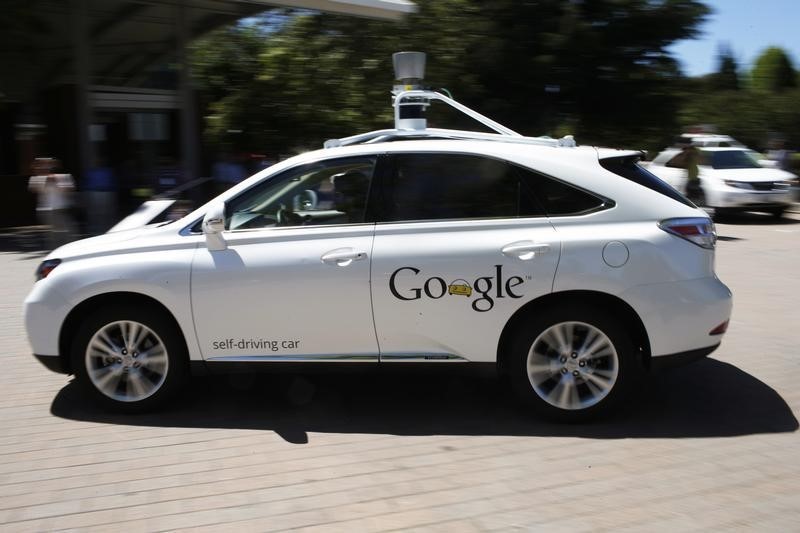By Paul Lienert and Joseph White
DETROIT (Reuters) - From his laboratory at Pittsburgh's Carnegie Mellon University, automated vehicle pioneer Raj Rajkumar says self-driving cars will evolve step-by-step, with humans staying in charge for a long time to come.
More than 2,500 miles west in Mountain View, California, Chris Urmson, head of Google Inc's (O:GOOGL) self-driving car program since 2009, has a different view: A fully automated vehicle that requires no input or intervention from humans is a safer choice, and one that could be ready for production by 2020.
Partially automating a car can reduce certain accident risks, but can also create new safety challenges not easily solved by current technology. Urmson, one of Rajkumar's former colleagues at Carnegie Mellon, said he worries that drivers could muff the handoff when an automated system suddenly demands they start making decisions about where to steer.
"The better the technology gets," he said, "the less reliable the driver is going to get."
Google's all-in approach differs from the auto industry's strategy on autonomous vehicle technology that will manifest itself in vehicles consumers can buy over the next two to three years.
Mainstream automakers General Motors Co (N:GM) and Volkswagen AG (DE:VOWG_p) and newcomer Tesla Motors Inc (O:TSLA) are pushing down the road to automation outlined by Rajkumar. They are accelerating plans to bring automated driving to the market in stages, starting as early as this year. A small group of Tesla owners is testing its "Autopilot" system that will allow hands-free highway cruising and automated parking. Tesla said it expects to offer the technology more widely later this year.
Technology that allows a car to park itself is already on the market, and a growing number of vehicles are equipped with systems that automatically apply the brakes, correct the steering or maintain a set distance from a vehicle ahead in the lane.
The automakers' rush to partially automated driving is moving faster than regulators can prescribe new rules of the road. Some experts - Urmson is one - are concerned that drivers may not respond well to cars that let them surrender control for long stretches.
Alerting a driver to retake control during an emergency is one of the biggest safety challenges for manufacturers of partially automated cars, industry officials and scientists said.
Depending on the level of automation and intensity of alert, some drivers took an average of 17 seconds to respond to a takeover request and regain control of the vehicle, in a study just released by the National Highway Traffic Safety Administration and supported by Google and several leading automakers and suppliers. In that time, a car traveling at 60 miles per hour would travel more than a quarter of a mile.
Time to respond and regain control was reduced to just a few seconds when visual and audible warnings were accompanied by non-visual alerts such as a nudge from a mechanism in the seat.
But "there were alerts that were missed" by some study participants, NHTSA said. When drivers shift their attention to other tasks in a self-driving vehicle, such as sending an e-mail, "their readiness to respond to driving-related prompts and alerts can be delayed."
There's value in "driver assistance" features such as brakes that engage automatically when the car's sensors detect an imminent crash, Urmson said. But a fully automated vehicle "can be much safer than a driver assistance system can ever be."
The behavior of drivers in automated cars is one issue. Another is the interaction between robot cars and those piloted by people. Google's Urmson has highlighted that issue in dissecting the causes of a series of incidents in which the company's self-driving cars were hit by conventional vehicles.
REAR-ENDED
In an August 20 incident, a Google self-driving prototype was rear-ended while stopped for a pedestrian in a crosswalk near the company's Mountain View headquarters. At the time, the driver of the Google vehicle had taken manual control after the car had begun to automatically brake for the pedestrian. Urmson speculated that the driver of the other vehicle may have glanced away while changing lanes.
Unresolved questions aren't stopping automakers and automotive suppliers from cashing in on partial automation, in part because the incremental approach promises more revenue in the near term than keeping technology in the lab.
Automotive technology companies such as Continental AG (DE:CONG) and Silicon Valley names such as chipmaker Nvidia Corp (O:NVDA) are working with automakers on semi-automated systems as well as supporting Google's project. Last month, Delphi Automotive Plc (N:DLPH), a global auto supplier in the forefront of automated vehicle development, acquired Ottomatika, a CMU spinout that originated in Rajkumar's lab.
Semi-automated driver assistance systems are expected to add $3,000 or more to the cost of cars. There are no consistent estimates on the cost of a fully automated vehicle.
The entire auto industry is waiting for highway safety regulators at NHTSA to clarify their position on Tesla's Autopilot and similar technology.
"The agency is in regular contact with the many companies that are developing such technologies, and we are working with all of them to help ensure that these innovations realize their safety potential," NHTSA said in a statement Aug 31.
In July, NHTSA chief Mark Rosekind said the agency is reviewing federal vehicle safety rules that could affect self-driving vehicles.

"We are trying to figure out if innovation will run up against regulations," Rosekind said.